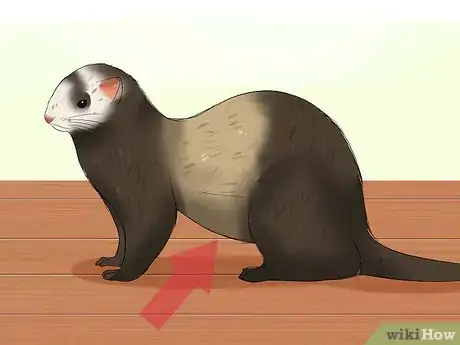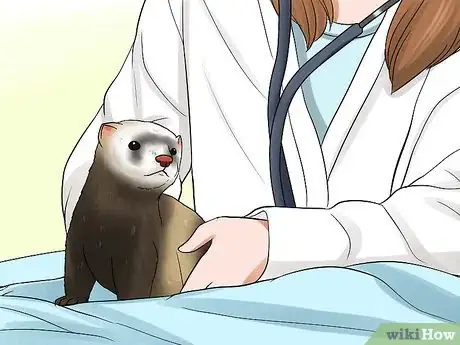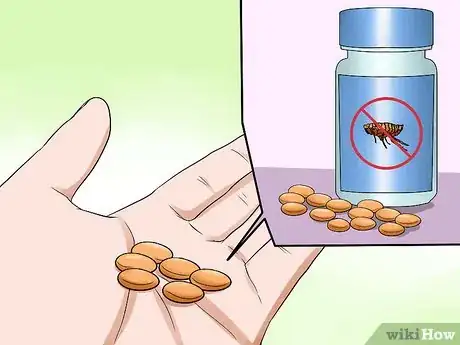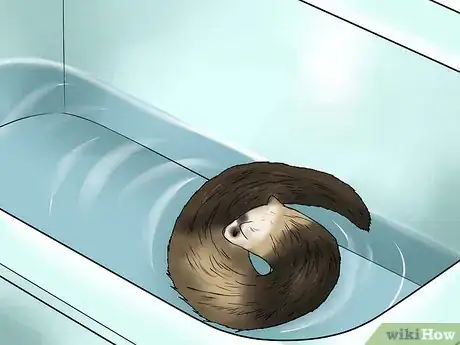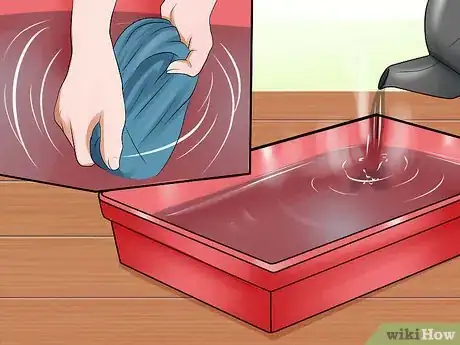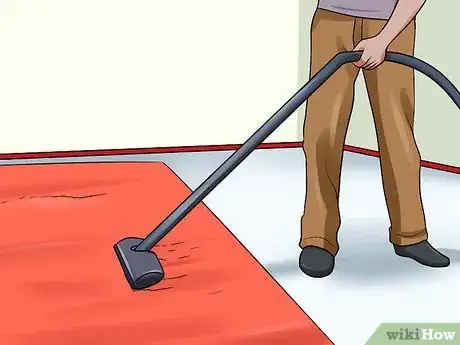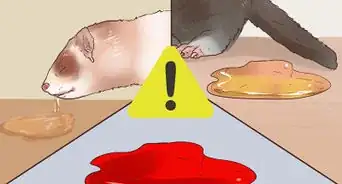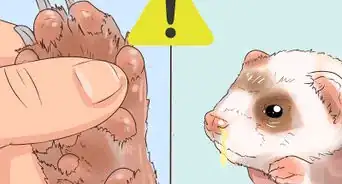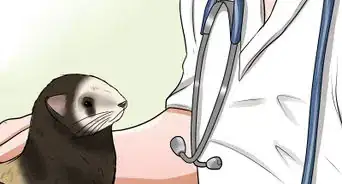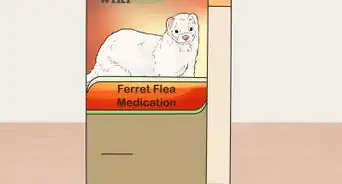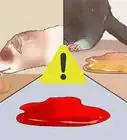This article was co-authored by Pippa Elliott, MRCVS. Dr. Elliott, BVMS, MRCVS is a veterinarian with over 30 years of experience in veterinary surgery and companion animal practice. She graduated from the University of Glasgow in 1987 with a degree in veterinary medicine and surgery. She has worked at the same animal clinic in her hometown for over 20 years.
There are 8 references cited in this article, which can be found at the bottom of the page.
This article has been viewed 23,471 times.
Tapeworms (Dipylidium caninum) are intestinal parasites that occur when an animal swallows a flea carrying tapeworm eggs. Ferrets are just as susceptible to tapeworms as dogs and cats. Although your ferret probably stays inside, other pets (or maybe even you!) may carry in fleas from the outside that would land on your ferret and start biting him.[1] Your ferret could swallow them in the process of grooming, and thus get tapeworms.[2] Treating your ferret for tapeworms should be done promptly and involves a combination of killing the tapeworms and preventing flea infestations.
Steps
Treating the Tapeworms
-
1Check your ferrets for fleas. Your ferret can get tapeworms by swallowing infected fleas. If your ferret is scratching, comb through his fur with a fine-toothed flea comb,[3] which is available at your local pet store.
- Focus on the area between his shoulder blades—this is a popular ‘flea’ spot on ferrets.[4]
- If you don’t see the actual fleas, you may see their residue, which is dark black.[5]
- Check the bottom of your ferret’s cage, and on the floor around his cage. Fleas that have jumped off him will look reddish brown to black and will be about the size of a pencil tip.[6] Use a magnifying glass to find the fleas, or flea residue, more easily.
-
2Recognize the clinical signs of tapeworm. When your ferret swallows an infected flea, the tapeworm eggs will attach to his intestinal walls. As the eggs grow into mature tapeworms, they will absorb the nutrients from the food your ferret eats. Consequently, your ferret will start to show signs of digestive upset, such as diarrhea and vomiting, as well as lose weight.[7]Advertisement
-
3Take your ferret to your veterinarian. Due to their small size, ferrets can become very sick from tapeworms. In addition to the digestive problems, the fleabites could cause enough blood loss to make your ferret dangerously anemic. Your ferret will need treatment right away.
- Tapeworms are eliminated from your ferret’s body through his feces. The tapeworms will look like tiny grains of white rice. They might even be wriggling around![10] Dried up tapeworms resemble sesame seeds.
- Bring a sample of the tapeworm-containing feces to your veterinarian when you bring your ferret in. Your veterinarian will analyze the feces to confirm the tapeworms.
-
4Give your ferret tapeworm-killing medicine. Treating tapeworms in ferrets is a two-pronged approach: killing the tapeworms and preventing flea infestations. To kill the tapeworms, your veterinarian will prescribe an anti-parasite medication called an anthelmintic—usually ivermectin or praziquantel. These medications are also used in dogs and cats, but your veterinarian will prescribe a much smaller dose for your ferret because of his small size.
- The medications come in either an injectable or oral formulation.
- Giving medicine to a ferret can be challenging.[11]
- To give him a pill, scruff him by grabbing the loose skin at the back of his neck. Tilt his head backwards. When he naturally relaxes and yawns, put your fingers in the front or side of his mouth and angle the pill towards the back of his mouth. Scruff him until you know he has swallowed the pill.[12]
- You may want to turn your head away, in case your ferret decides to spit out the pill.[13]
- If your ferret refuses to swallow the pills, speak with your veterinarian about other ways to get your ferret to take his medicine.
- If you are uncomfortable giving medicine to your ferret, ask your veterinarian for tips on how to do it safely and effectively.
- With treatment, the tapeworms will die and be digested in your ferret’s intestines. You will not see dead tapeworm segments in his feces.[14]
Preventing Flea Infestations
-
1Bathe your ferret. As if suffering through a tapeworm infestation was bad enough, your ferret could get infected again if there are fleas (and flea eggs) lingering around in the environment. One way to kill any remaining fleas is to bathe your ferret. Select a shampoo that contains pyrethrins, which are insecticides that effectively kill fleas.[15] Because your ferret is small, choose a shampoo that is suitable for a kitten.[16]
- Since there may be a number of pyrethrin-containing shampoos to choose from at your local pet store, talk with your veterinarian first for recommendations on which shampoo would be best.
- The shampoo should not contain organophosphates, carbamates, or petroleum distillates.[17] These can be toxic to your ferret.
- Bathe your ferret from his ears to his tail. Use a flea comb to remove the fleas from his face.[18]
- Depending on the severity of your ferret’s flea infestation, you may need to bathe him weekly for several weeks to kill all of the fleas and flea eggs.[19]
- Read the product label carefully and follow the instructions exactly.
- Do not use flea sprays or dips to bathe your ferret. Compared to shampoo, these products are very toxic to your ferret.[20]
-
2Clean your ferret’s bedding. Another way to get rid of the fleas is to wash all of his bedding in hot water. To be on the safe side, wash his bedding several times. Do not use fabric softener when washing the bedding.
-
3Clean your ferret’s cage. Cleaning your ferret’s cage will involve cleaning the cage itself, as well as all of its contents: food and water bowls, toys, and furniture. There are several options for cleaning agents, such as diluted bleach (1/2 cup bleach per 1 gallon of water). Your veterinarian may also be able to recommend ferret-safe disinfectants.[21]
- In addition to disinfectant, you will need one or two buckets, a pair of gloves, sponges, and some cleaning towels or paper towels. Also, have some brushes in a variety of sizes to target all the little corners and crevices in his cage.[22]
- Clean his food and water bowls in hot, soapy water.[23]
- Put your ferret in his playpen or separate cage while you clean the cage and let it dry.[24]
- Your veterinarian may also recommend spraying the cage and its contents (not the food and water bowls, of course) with a ferret-safe flea spray.
-
4Vacuum frequently. To make sure no fleas or flea eggs remain in your home, you will probably need to vacuum like it’s going out of style! Cut a flea collar and place it in the vacuum bag to kill any flea eggs that wind up in the bag.[25] Replace the vacuum bag frequently.
- In addition to vacuuming, you can apply flea spray or flea powder to your floors.[26] Speak with your veterinarian about which sprays and powders are ferret-safe.
-
5Apply a topical flea preventative to your ferret’s skin. Regular application of a topical flea preventative, such as Frontline or Advantage, will help kill the adult fleas on your ferret’s skin, as well as stop the development of flea eggs and larvae.[27] Because of your ferret’s size, he should receive the dosage recommended for kittens (less than five pounds).
- Make sure to purchase flea preventatives only through your veterinarian—do not order them online or from a pet store. Products that are not sold through your veterinarian may be counterfeit.
- Follow the label instructions carefully when applying the medication.
Warnings
- People can get tapeworms, too, if they swallow infected fleas.⧼thumbs_response⧽
- A severe flea infestation can make your ferret very anemic due to blood loss. Your ferret may need additional treatments to address the anemia.⧼thumbs_response⧽
- You may need to ‘flea bomb’ your house if the flea infestation is severe. The flea bomb is a fogger than contains a flea-killing substance called methoprene. Professional companies are available that provide this service.⧼thumbs_response⧽
- Do not use flea collars on your ferret. They can cause severe skin irritation and lead to serious health problems.[30]⧼thumbs_response⧽
- If left untreated, tapeworms can grow up to three feet long in the intestines.[31]⧼thumbs_response⧽
References
- ↑ http://www.cypresskeep.com/Ferretfiles/Parasites-FM.htm
- ↑ http://www.cypresskeep.com/Ferretfiles/Parasites-FM.htm
- ↑ http://www.cypresskeep.com/Ferretfiles/Parasites-FM.htm
- ↑ http://www.cypresskeep.com/Ferretfiles/Parasites-FM.htm
- ↑ http://www.cypresskeep.com/Ferretfiles/Parasites-FM.htm
- ↑ http://www.cypresskeep.com/Ferretfiles/Parasites-FM.htm
- ↑ http://www.allaboutworms.com/types-of-ferret-worms
- ↑ http://www.allaboutworms.com/types-of-ferret-worms
- ↑ http://www.cypresskeep.com/Ferretfiles/Parasites-FM.htm
- ↑ http://miamiferret.org/faq.htm
- ↑ http://www.ferretuniverse.com/resources/giving_meds.asp
- ↑ http://www.ferretuniverse.com/resources/giving_meds.asp
- ↑ http://www.ferretuniverse.com/resources/giving_meds.asp
- ↑ http://www.vcahospitals.com/main/pet-health-information/article/animal-health/tapeworm-infection-in-cats/349
- ↑ http://www.peteducation.com/article.cfm?c=26+1303&aid=1359
- ↑ http://www.cypresskeep.com/Ferretfiles/Parasites-FM.htm
- ↑ http://www.cypresskeep.com/Ferretfiles/Parasites-FM.htm
- ↑ http://www.cypresskeep.com/Ferretfiles/Parasites-FM.htm
- ↑ http://www.cypresskeep.com/Ferretfiles/Parasites-FM.htm
- ↑ http://www.cypresskeep.com/Ferretfiles/Parasites-FM.htm
- ↑ http://www.peteducation.com/article.cfm?c=11+2066&aid=3609
- ↑ http://www.peteducation.com/article.cfm?c=11+2066&aid=3609
- ↑ http://www.peteducation.com/article.cfm?c=11+2066&aid=3609
- ↑ http://www.peteducation.com/article.cfm?c=11+2066&aid=3609
- ↑ http://www.cypresskeep.com/Ferretfiles/Parasites-FM.htm
- ↑ http://www.cypresskeep.com/Ferretfiles/Parasites-FM.htm
- ↑ http://www.peteducation.com/article.cfm?c=1+2127&aid=590
- ↑ http://www.allaboutworms.com/types-of-ferret-worms
- ↑ http://miamiferret.org/faq.htm
- ↑ http://www.cypresskeep.com/Ferretfiles/Parasites-FM.htm
- ↑ http://www.allaboutworms.com/types-of-ferret-worms
About This Article
To treat tapeworms in your ferret, comb its fur regularly with a tooth comb to remove fleas, since ferrets contract tapeworm by swallowing infected fleas. When you notice signs of tapeworm, like weight loss, diarrhea, or vomiting, take your ferret to your vet right away for treatment. Make sure to bring a sample of its feces with you, which your vet will examine to confirm the diagnosis. Afterwards, give your ferret the anti-parasite pills prescribed by your vet. If your ferret won’t swallow the tablets, talk to your vet about injecting the medication, which will kill the tapeworms. For tips from our Veterinary co-author on how to combat infected fleas with a topical formula, keep reading!

